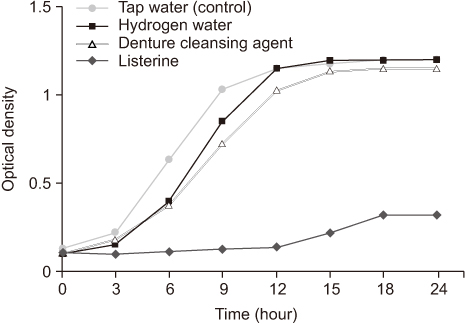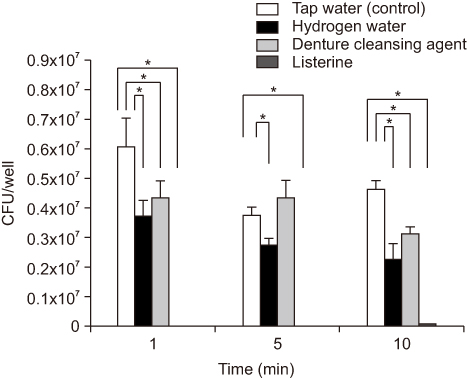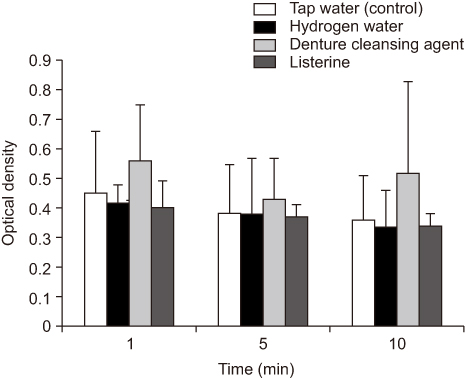J Korean Acad Oral Health.
2019 Dec;43(4):173-177. 10.11149/jkaoh.2019.43.4.173.
Antifungal effects of hydrogen water on the growth of Candida albicans
- Affiliations
-
- 1Department of Preventive Dentistry, School of Dentistry, Kyungpook National University, Daegu, Korea.
- 2Department of Dental Hygine, College of Science & Technology, Kyungpook National University, Sangju, Korea. jinha01@naver.com
- KMID: 2467822
- DOI: http://doi.org/10.11149/jkaoh.2019.43.4.173
Abstract
OBJECTIVES
This study assessed the antifungal effects of neutral electrolysis hydrogen water, an agent known for its oral anti-bacterial effects on the growth of C. albicans in vitro.
METHODS
Hydrogen water, denture cleansing agent, and Listerine® were compared to a tap water control. We serially cultured C. albicans KCTC 27239 in SD media to analyze the inhibitory effect of each treatment on growth. We evaluated the data using repeated-measures ANOVA test and one-way ANOVA test, and a significant difference was defined as P < 0.05.
RESULTS
Hydrogen water significantly inhibited the growth, but not the biofilm formation, of C. albicans compared to tap water control at 1-, 5-, and 10-minute time points (P < 0.05).
CONCLUSIONS
The growth of C. albicans was slower in hydrogen water than in tap water, thereby suggesting an inhibitory effect of hydrogen water. Hydrogen water may, therefore, be utilized as an antibacterial and preventive agent without any harmful effect on denture and oral tissues.
Keyword
MeSH Terms
Figure
Reference
-
1. Arendorf TM, Walker DM. Denture stomatitis: a review. J Oral Rehabil. 1987; 14:217–227.
Article2. Calderone RA, Fonzi WA. Virulence factors of Candida albicans. Trends Microbiol. 2001; 9:327–335.
Article3. Shafer WC, Hine MK, Levy BM. A textbook of oral pathology. 4th ed. Philadelphia: WB Saunders Co.;1983. p. 393–397.4. Budtz-Jörgensen E, Stenderup A, Grabowski M. An epidemiologic study of yeasts in elderly denture wearers. Community Dent Oral Epidemiol. 1975; 3:115–119.
Article5. Stohler C. Etiology and occurrence of denture stomatitis: a review of the literature. Schweiz Monatsschr Zahnmed. 1984; 94:187–194.6. Kim YJ. Pathogenic microorganisms & antibiotics. Seoul: World science;2010. p. 349–354.7. Paranhos HF, Silva-Lovato CH, Souza RF, Cruz PC, Freitas KM, Peracini A. Effects of mechanical and chemical methods on denture biofilm accumulation. J Oral Rehabil. 2007; 34:606–612.
Article8. Murdoch-Kinch CA, Mallatt ME, Miles DA. Oral mucosal injury caused by denture cleanser tablets: a case report. Oral Surg Oral Med Oral Pathol Oral Radiol Endod. 1995; 80:756–758.9. Izumi S, Ryu M, Ueda T, Ishihara K, Sakurai K. Evaluation of application possibility of water containing organic acids for chemical denture cleaning for older adults. Geriatr Gerontol Int. 2016; 16:300–306.
Article10. Zhang JY, Liu C, Zhou L, Qu K, Wang R, Tai MH, et al. A review of hydrogen as a new medical therapy. Hepatogastroenterology. 2012; 59:1026–1032.
Article11. Jeng ES, Kim DH, Lee KJ. The antioxidative effect of hydrogen water drinking in blood. Korean J Waters. 2016; 5:25–28.12. Lee SH, Baek DH. Antibacterial activity of hydrogen-rich water against oral bacteria. Int J Oral Biol. 2013; 38:81–85.
Article13. Pyo KR, Yoo YS, Baek DH. Antifungal effect of electrolyzed hydrogen water on Candida albicans biofilm. J Dent Rehabil Appl Sci. 2015; 31:212–220.
Article14. Holladay JD, Hu J, King DL, Wang Y. An overview of hydrogen production technologies. Catal Today. 2009; 139:244–260.
Article15. Waters B, Amazonas M, Hung YC. Electrolyzed oxidizing water generation methods. J Funct Water. 2012; 7:1–13.16. Kim J, Lee HJ, Hong SH. Inhibition of streptococcal biofilm by hydrogen water. J Dent. 2017; 58:34–39.
Article17. Weerasekera MM, Wijesinghe GK, Jayarathna TA, Gunasekara CP, Fernado N, Kottegoda N, et al. Culture media profoundly affect Candida albicans and Candida tropicalis growth, adhesion and biofilm development. Mem Inst Oswaldo Cruz. 2016; 111:697–702.
Article18. Kim YM, Choi YS, Cho IH. Cleansing effect of the alkaline ionized water on microorganisms of the denture surface. J Korean Acad Prosthodont. 2011; 49:138–144.
Article19. Kiura H, Sano K, Morimatsu S, Nakano T, Morita C, Yamaguchi M, et al. Bactericidal activity of electrolyzed acid water from solution containing sodium chloride at low concentration, in comparison with that at high concentration. J Microbiol Methods. 2002; 49:285–293.
Article20. Nakagawara S, Goto T, Nara M, Ozawa Y, Hotta K, Arata Y. Spectroscopic characterization and the pH dependence of bactericidal activity of the aqueous chlorine solution. Anal Sci. 1998; 14:691–698.
Article21. Baran I, Nalçacı R. Self-reported denture hygiene habits and oral tissue conditions of complete denture wearers. Arch Gerontol Geriatr. 2009; 49:237–241.
Article22. Saitoh Y, Harata Y, Mizuhashi F, Nakajima M, Miwa N. Biological safety of neutral-pH hydrogen-enriched electrolyzed water upon mutagenicity, genotoxicity and subchronic oral toxicity. Toxicol Ind Health. 2010; 26:203–216.
Article
- Full Text Links
- Actions
-
Cited
- CITED
-
- Close
- Share
- Similar articles
-
- Antifungal effect of electrolyzed hydrogen water on Candida albicans biofilm
- Studies on sensitivity and synergism of antifungal agents against candida albicans
- Antifungal Activity of the Extracts from Galla rhois against Candida albicans
- Antifungal Activity of the Extract from Paeonia japonica against Candida albicans
- INHIBITORY EFFECT OF ANTIFUNGAL AGENTS INCORPORATED IN DENTURE LINING MATERIALS AGAINST CANDIDA ALBICANS




